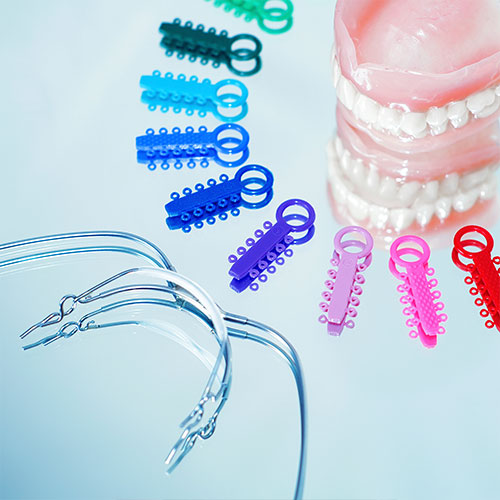Let’s keep it real. Braces can feel a little weird at first, but we promise you’ll get used to them. You’ll be able to go about your regular day-to-day activities with your usual enthusiasm. We’ll teach you how to adapt to life with braces and give you tons of tips for a comfortable experience. Though the transition is fairly easy, there are a few things to keep in mind:
Brushing your teeth is basically the same with or without braces, but with braces you’ll have to step up your brushing game a bit and make sure to get in and around all those nooks and crannies after each meal. You probably don’t want to smile at your crush and unwittingly have a piece of lettuce stuck in your braces. Brushing will help you avoid some potentially embarrassing situations. But it also helps to ward off permanent stains, cavities and inflammation of the gums.
Make sure you brush the inside, outside, and biting surface of your teeth. Angle your toothbrush towards the gums and wiggle it back and forth to get those bristles between the wires and brackets. Also, be sure to gently brush the gum line. You’ve heard it before, and you’re going to hear it again: You should be brushing your teeth for about two minutes each time! Don’t forget to replace that toothbrush every three months and to continue seeing your dentist for check ups every six months.
In a pinch, you can rinse your mouth out after a snack or meal. Although brushing is the way to go, we’re realistic and realize you probably won’t have your toothbrush with you 24 hours a day. Rinse your mouth with water and then brush when you get home.
Flossing is a little trickier with braces. Flossing once a day will help you maintain a sparkling, clean smile. You will need a floss threader to pass the floss under the main wire and then in between two teeth. Slide the floss up and down on each side of the tooth before moving on to the next pair of teeth. You’ll quickly get the hang of a floss threader.


Fortunately braces won’t cramp your snacking style too much. You can still eat most of the foods you love. Right after getting your braces on and following adjustments, you may want to stick with softer foods and cold drinks if your teeth feel tender.
Cut or break hard and chewy foods into bite-sized pieces and strip food like corn on the cob. Make everything as easy to eat as possible. As your teeth move into position, you may need to switch up your chewing habits. Chew everything with your back teeth and avoid biting with your front teeth.
True to our dentist roots, we don’t recommend sticky, sugary foods, like caramel, with braces, and it’s best to avoid popcorn and foods that will get stuck between brackets, which can cause inflammation or broken braces. Limit your intake of soda and other extremely sugary beverages as well because the sugar can lead to tooth decay. Our team is here for you if you’re unsure or have any questions.
In the rare event that an orthodontic discomfort pops up, we’re here for you. Call us and we’ll get you in for an appointment to fix the issue, if necessary. In the meantime, we’ve listed a few temporary home remedies to keep you comfortable with some of the common braces discomforts:
Poking Wires
As your teeth move sometimes wires may poke out. Ugh. We feel your pain. Luckily there are some quick fixes:


This is the most common issue and might be due to certain foods (we’re looking at you taffy), physical trauma to the mouth, or saliva contamination during the bonding procedure. Here’s the solution:
Sometimes it takes a few days to get used to braces. During this adjustment period, the brackets and wires can irritate the lips and cheeks.
Again, wax will be your best friend. Dry the bracket with cotton or a tissue, take a small piece of wax and roll it into a ball and place it over the bracket and wire. That should do the trick. If the irritation continues, give us a call and we’ll help you out.

There are very few true orthodontic emergencies and it is our goal to keep emergency visits to our office a minimum. Most problems that arise can be remedied at home. However, if you have a situation that you cannot resolve on your own, call us as soon as possible. Allowing your appliance to remain damaged for an extended period of time may result in disruptions in your treatment plan and extended time in braces.
If the band/bracket is still attached to the wire, leave in place. If uncomfortable, place wax on it. If it comes out completely, wrap bracket/band in tissue. Call our office to schedule a repair visit. Call even if you have an upcoming appointment since repairs of this nature usually take additional time. Broken appliances will delay treatment time and need to be repaired as soon as possible.
Try to place wire back in place with tweezers or needle nose pliers. If that is not possible, clip the wire with fingernail clippers behind the last tooth to which it is securely fastened. Remember that IF YOU CLIP THE WIRE, THE CLIPPED PIECE MUST BE REMOVED FROM YOUR MOUTH TO AVOID SWALLOWING. Use a folded tissue or gauze around the area to catch the piece. If uncomfortable, place wax on it.
If a wire causes irritation, using a pencil eraser or a Q-tip, push the poking wire down and away from the area, or place wax on it to alleviate the discomfort.
Step 1 – Ball up a small amount of the wax with your fingers
Step 2 – Dry off your brace with a paper towel
Step 3 – Mash the wax against your bracket to make a small comfort mound.
Replace if neccesary. And don’t worry if you happen to swallow this, it’s just wax.
If you play any sports that normally require a mouthguard without braces, we recommend you wear one with braces. Ask us at your next appointment and we will show you what an orthodontic mouthguard looks like. They are available in the office and at most retail stores. They can definitely help prevent many orthodontic emergencies.
If you lose a separator, please call our office to determine if it needs to be replaced. You can reposition the spacer by taking two pieces of dental floss and inserting them through the spacer. Pull on both pieces of floss to stretch the spacer, then slide the spacer back and forth between the two teeth where it belongs. Once the bottom half of the spacer slips under the tight spot between the teeth, release and remove the floss and the spacer will fit back properly. If you do not feel comfortable placing a spacer, another option is to arrive 10-15 minutes early to your next appointment to allow the spacer to be re-inserted prior to proceeding with the scheduled appointment.
When you first get your braces, you may notice that your teeth and mouth feel a little tender or sore. This is perfectly normal for patients who have just gotten their braces, and we promise your mouth will not be sore forever! Pain can be a result of sores/ulcers on your soft tissue (lips, cheeks, tongue) or from your teeth responding to the forces of the braces. To relieve the pain associated with sores or ulcers, we recommend dissolving one teaspoon of salt in eight ounces of lukewarm water. Swish and gargle this solution in your mouth for just a couple of minutes then spit out (do not swallow the salt water). To relieve pain associated with your teeth, we recommend chewing sugar free gum.
If the pain is more severe and does not go away after you’ve tried the above recommendations, you can also try taking an over-the-counter pain reliever (such as Tylenol or whatever is normally taken for a headache or similar pain). It is not uncommon for your lips, cheeks, and tongue to become irritated for one to two weeks as they toughen and become used to the braces. Wax can be placed over the braces to lessen the tenderness. If you need extra wax, please let us know!